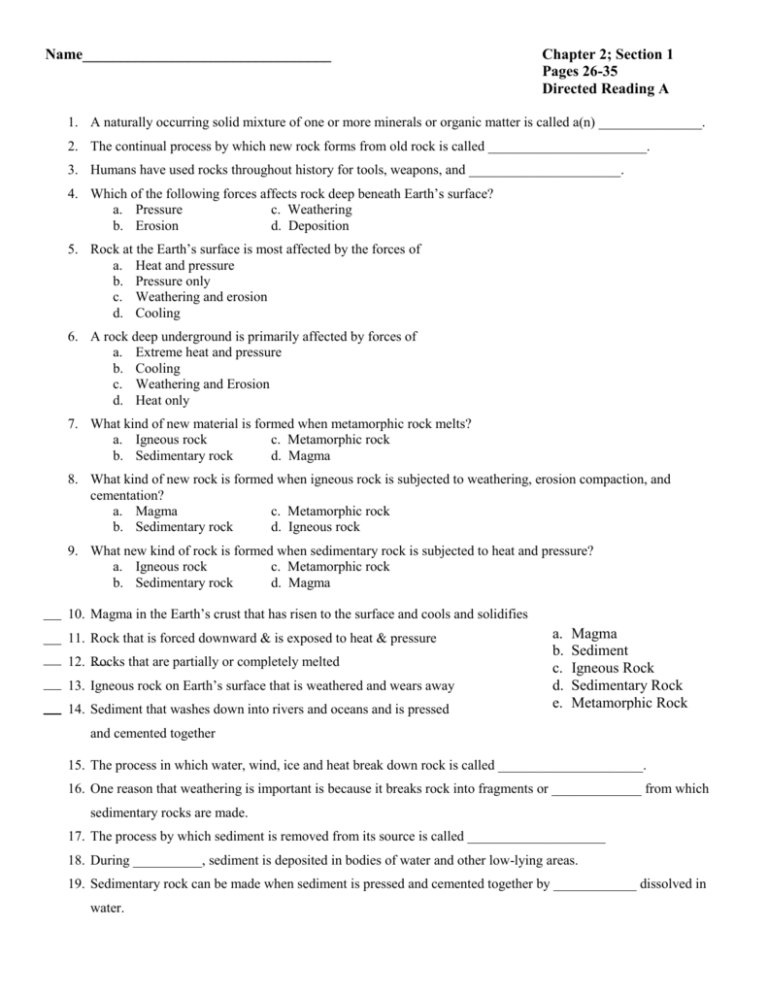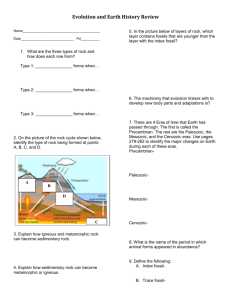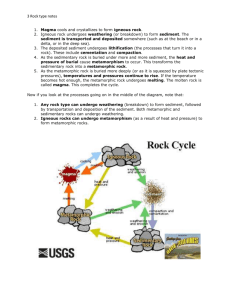Directed Reading 2.1 A
advertisement

Name_________________________________ Chapter 2; Section 1 Pages 26-35 Directed Reading A 1. A naturally occurring solid mixture of one or more minerals or organic matter is called a(n) _______________. 2. The continual process by which new rock forms from old rock is called _______________________. 3. Humans have used rocks throughout history for tools, weapons, and ______________________. 4. Which of the following forces affects rock deep beneath Earth’s surface? a. Pressure c. Weathering b. Erosion d. Deposition 5. Rock at the Earth’s surface is most affected by the forces of a. Heat and pressure b. Pressure only c. Weathering and erosion d. Cooling 6. A rock deep underground is primarily affected by forces of a. Extreme heat and pressure b. Cooling c. Weathering and Erosion d. Heat only 7. What kind of new material is formed when metamorphic rock melts? a. Igneous rock c. Metamorphic rock b. Sedimentary rock d. Magma 8. What kind of new rock is formed when igneous rock is subjected to weathering, erosion compaction, and cementation? a. Magma c. Metamorphic rock b. Sedimentary rock d. Igneous rock 9. What new kind of rock is formed when sedimentary rock is subjected to heat and pressure? a. Igneous rock c. Metamorphic rock b. Sedimentary rock d. Magma 10. Magma in the Earth’s crust that has risen to the surface and cools and solidifies 11. Rock that is forced downward & is exposed to heat & pressure 12. Rocks that are partially or completely melted 13. Igneous rock on Earth’s surface that is weathered and wears away 14. Sediment that washes down into rivers and oceans and is pressed a. b. c. d. e. Magma Sediment Igneous Rock Sedimentary Rock Metamorphic Rock and cemented together 15. The process in which water, wind, ice and heat break down rock is called _____________________. 16. One reason that weathering is important is because it breaks rock into fragments or _____________ from which sedimentary rocks are made. 17. The process by which sediment is removed from its source is called ____________________ 18. During __________, sediment is deposited in bodies of water and other low-lying areas. 19. Sedimentary rock can be made when sediment is pressed and cemented together by ____________ dissolved in water. 20. Some ___________ rock is made when sediment is squeezed by the weight of the rock materials that lies above it. 21. Movement within the Earth that causes buried rock to be exposed at the Earth’s surface is called _____________. 22. Beyond the three basic rock types, rocks can be divided into subcategories based on a. Composition and texture b. The depth at which they form c. Elevation d. The pressure under which they form 23. What is the chemical makeup, or mineral content, or a rock based on? a. The size of its grains b. The position of its grains c. The shape of its grains d. Its composition 24. What do the size, shape, and positions of the grains that make up a rock determine? a. The rock’s texture b. The rock’s size c. The rock’s color d. The rock’s composition 25. What factors can affect the texture of a sedimentary rock? a. The length of time the magma had to cool b. The temperature the rock was exposed to c. The color of the rock d. The size of the grains that make up the rock 26. What factors can affect the texture of an igneous rock? a. The length of time the rock had to cool b. The size of the rock c. The minerals that cement the rock together d. The pressure & temperature the rock was exposed to 27. What factors can affect the texture of a metamorphic rock? a. The length of time the magma had to cool b. The pressure & temperature the rock was exposed to c. The minerals that cement the rock together d. The size of the grains that make up the rock







